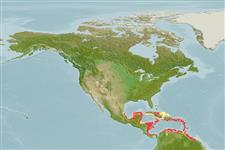Common names from other countries
Environment: milieu / climate zone / depth range / distribution range
Écologie
; profondeur 0 - 44 m (Ref. 83435). Tropical; 23°N - 6°N, 93°E - 53°E (Ref. 83435)
Distribution
Pays | Zones FAO | Écosystèmes | Occurrences | Introductions
Western Central Atlantic.
Length at first maturity / Taille / Poids / Âge
Maturity: Lm ? range ? - ? cm Max length : 18.2 cm DL mâle / non sexé; (Ref. 83435); common length : 15.0 cm TL mâle / non sexé; (Ref. 355)
Description synthétique
Morphologie
Shell thick, pear-shaped, with large body whorl. Spire short, last few whorls bear single or double rows of spines. Suture deeply channelled. Anterior canal short and broad. Base of shell sometimes with a row of smaller, blunt spines. Colour: purplish brown, light grey, or white, with bluish, brownish or greyish bands.
Inhabits coastal lagoons, mangroves, river estuaries, and other low-salinity environments (Ref. 355).
Life cycle and mating behavior
Maturité | Reproduction | Frai | Œufs | Fécondité | Larves
This species is a non-broadcast spawner. Life cycle does not include trocophore stage. Also Ref. 833.
Leal, J.H. 2003. (Ref. 355)
Statut dans la liste rouge de l'IUCN (Ref. 130435)
statut CITES (Ref. 108899)
Not Evaluated
Not Evaluated
Menace pour l'homme
Harmless
Utilisations par l'homme
Pêcheries: commercial
| FishSource |
Outils
Plus d'informations
Taille/ÂgeCroissanceLongueur-poidsLongueur-longueurMorphologieLarvesAbondance
Sources Internet
Estimates based on models
Preferred temperature
(Ref.
115969): 26.4 - 28.2, mean 27.6 (based on 110 cells).
Catégorie de prix
Unknown.
